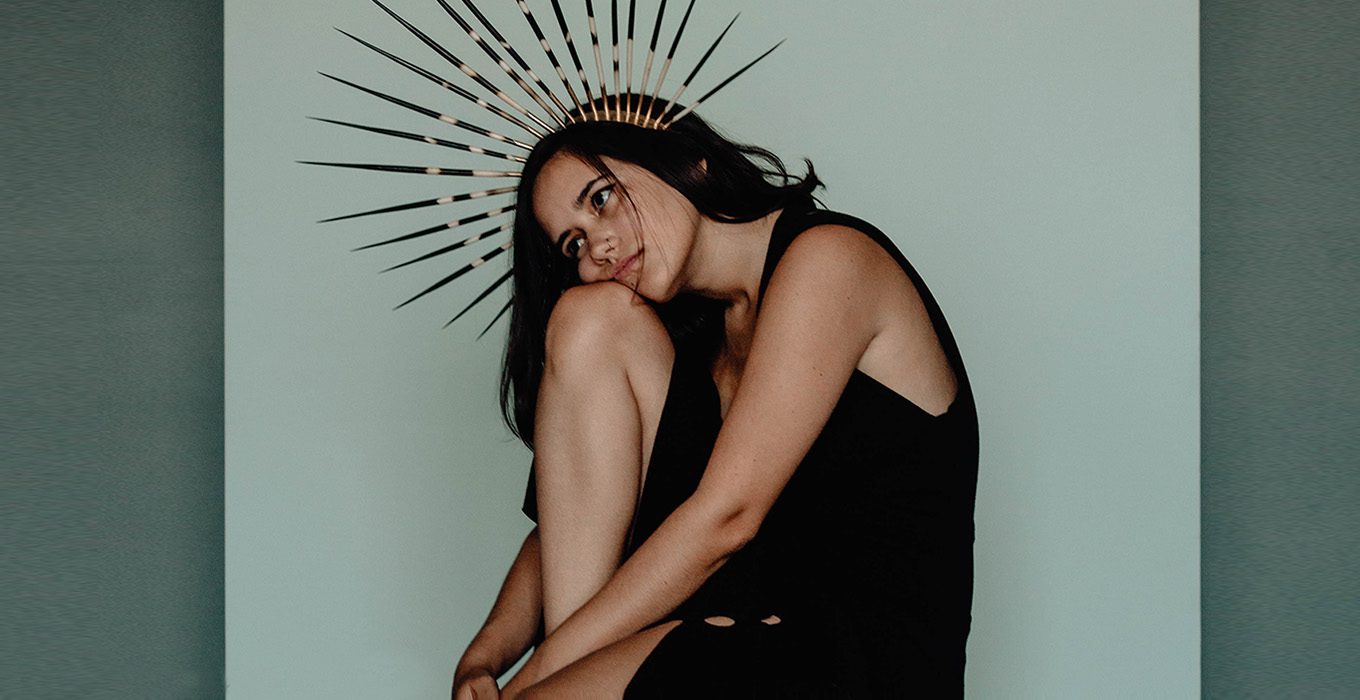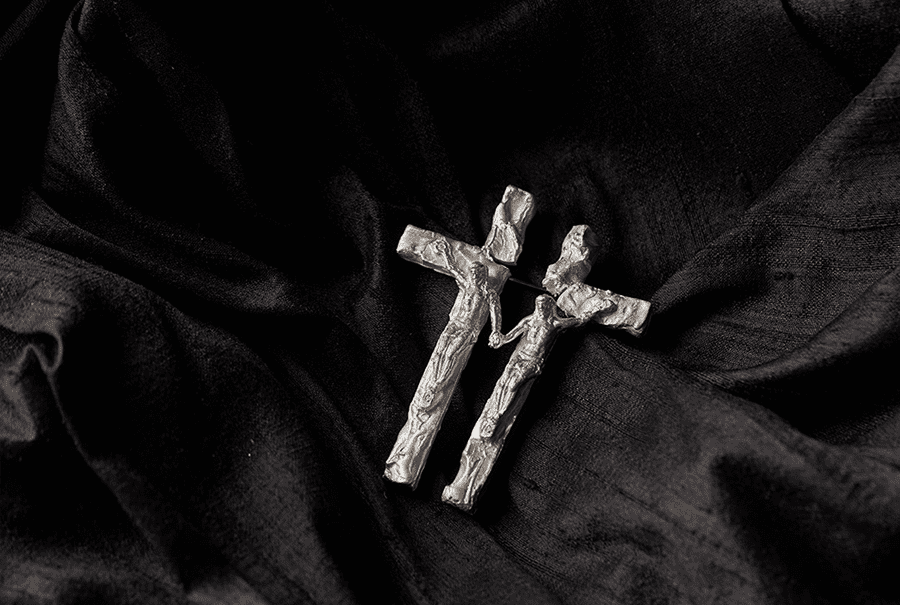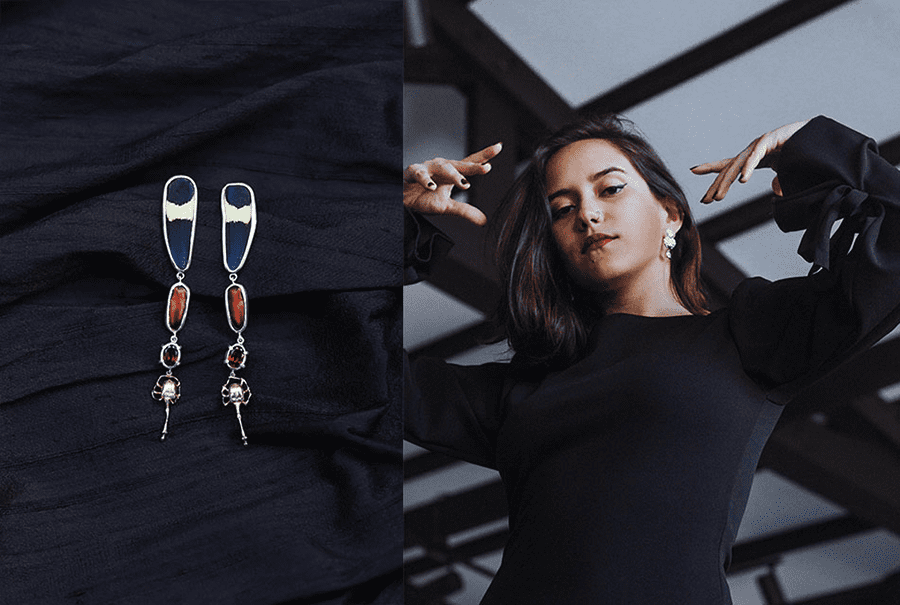

April 25, 2019
“Art can be dangerous, even when decorous”
(Bridget Quinn, 2017). There are two senses that strike the most when confronted with art: sight and touch. The former goes without saying, but ultimately we feel, though there is no physical convergence by art (and design)- and that is what makes it so very dangerous, as stated by Quinn.
We stand in awe at the confrontational force that lies within Mairi Millar’s work. It’s both rebellious and riveting. It’s the voice for all those who walk in vulnerability, but still, wear their strength on their sleeves, or in this case, their fingers, ears, and above their head. It is only fitting that this conversation is entitled, ‘Exhibitory,’ for the designs as well as the designer are far worth the exhibition.
Flashback to 10 year old Mairi… What was your envisioned “when I grow up” scenario?
MAIRI: An astronomer. I’m not sure I even knew what that entailed but I think I just had a deep curiosity for the unknown – and now I make beetle jewellery. So it’s kind of the same thing. That being said, I’m pretty sure I wanted to be a lion at some point as well. I’m the toddler that used to roar at people (and the resident emo child at the public catholic school), so I’m very familiar with reactions to the strange or out of place. It makes sense now that I look at my current work; roaring at strangers and sparking curiosity for the bizarre.
“I’m very familiar with reactions to the strange or out of place.”
I love that you wanted to be a lion! Was Art / Design always part of your life (pre-jewellrydesigner)?
MAIRI: Definitely, but I think I always had that push and pull that other creative people have growing up when deciding what type of career to pursue. There are a lot of artists in my family, but on the other hand, just as many doctors. My grandfather and my dad had their practice right next to my granny’s art supply store and it was always such a stark contrast – mirroring the left and the right brain. Save a life, or try to draw a river really well.
When I visited London with my family at eight years old, my perspective on art changed drastically. Imagine my mind jumping from our local, idyllic concept of art to Mark Quinn’s self- portrait in blood, or coming face to face with Damien Hirst’s preserved shark. The morbidity of medicine and science bled into the tame and idealized world of what I knew art to be. I realised art didn’t have to be a painting of some beach or even a painting in the first place – it didn’t even have to be traditionally attractive. And above all it could actively make people think, question and change.
Quite right! Concepts can span from all aspects of the human experience. I find it really intriguing how conceptual your designs are. The “Santimanitay” Collection, in particular, is very reflective of Trinidadian society, tell us more about that.
MAIRI: I don’t think I can really escape the influence Trinidad has on me because it’s understandably a big part of who I am. Not to mention the fact that there’s so much silence in our society when it comes to certain issues that it’s just begging to be commented on. Like many, my relationship with Trinidad is a deep love battled by fear and resentment. The title of the collection Santimanitay comes from the French “sans humanité” meaning without humanity or merciless. Since it’s used as a sort of mic-drop in our calypso extempo, I liked the idea that I was in a sort of back and forth with Trinidad and basically saying whatever you do to me, I’ll fire back and have something to say about it.
The collection comprises of jewellery that celebrates, mourns and mocks our culture, borrowing a lot of imagery from Carnival and Catholicism to do so; tackling issues including homophobia and misogyny.
“… I was in a sort of back and forth with Trinidad and basically saying whatever you do to me, I’ll fire back and have something to say about it.”
The piece that struck me the most was “Bullermen” and its commentary on homosexuality and how that notion is treated in Trinbagonian society. Can you tell us how this piece came to be?
MAIRI: In Trinidadian society, both fear and ignorance are still very common when it comes to homosexuality; it is seen as something meant to be hidden and ashamed of. Since jewellery as an artistic medium is meant to be seen and used as self expression – I’m trying to challenge that silence. We pride ourself on our diversity and cohabitation but that comes with a heavy asterisk – it’s conditional. Many still fear and look down on people who challenge their comfort zone and narrow scope on life.
In our still heavily Catholic society, homophobes commonly use scripture and their interpretations of it as a crutch and justification for their hate. My piece takes the form of an altered crucifix, duplicating Jesus on the cross to represent two men who have been crucified for their truth.
“We pride ourself on our diversity and cohabitation but that comes with a heavy asterisk – it’s conditional.”
Then we have the Aegis Collection, which is absolutely stunning. What stimulated the designs of this collection?
MAIRI: My title for the collection, “Aegis”, refers to the armour of Athena.
Jewellery is generally seen as a way to attract the gaze of ‘the other’, but as a woman I’m fascinated by making beautiful jewellery that also exudes strength; referencing the protective instruments used by prey. The spikes of a sea urchin, the quills of a porcupine, the shell of an abalone, they all act as protection and power.
However, I aim to elevate these materials to emphasize not the creature’s vulnerability but their strength, as of the women who wear them. Straying from the submissive and delicate beauty women are traditionally expected to possess, these pieces allow them to celebrate their beauty without being presented as garnished offerings to others. In short, this collection stems from a desire to balance the beautiful and the intimidating, the traditional and the unusual, and from a fascination with the potential that jewellery has to empower.
“… as a woman I’m fascinated by making beautiful jewellery that also exudes strength…”
You mentioned the words “vulnerability” and “women” in the same sentence, and it really struck a chord because I feel as though this particular conversation continues to plague all social and political platforms. What’s your take on it personally, and why did you feel it necessary to address this issue?
MAIRI: First of all, I am a woman. Being a woman generally means being conditioned to mould yourself to what society defines as “feminine” or “womanly”: to be gentle and “lady-like”; to be submissive.
There are so many times where the pressure to be “polite” overpowers our sense of discomfort and danger; where the fear to come off as a “bitch” has gotten us deeper into uncomfortable situations where we couldn’t say “no” or to leave us alone because that may sound aggressive, and women aren’t supposed to be that way. We’re supposed to smile, giggle, curtsy, roll over, play dead. “Lighten up”. “Doh be so”. We’re supposed to conform to what society deems as attractive and god forbid you’re one of those hairy makeup-less feminists; it probably means you just can’t find a man. We were never taught that there’s a huge difference between being rude, and respecting and protecting yourself and your boundaries.
Jewellery is not going to solve this deep rooted cultural and universal problem, but if I can use my passion and practice to make women feel a little more confident and powerful and have them stray a little from the norm, you’re damn right I will.
“We’re supposed to smile, giggle, curtsy, roll over, play dead. “Lighten up”. “Doh be so”. We’re supposed to conform to what society deems as attractive and god forbid you’re one of those hairy makeup-less feminists…”
“…if I can use my passion and practice to make women feel a little more confident and powerful and have them stray a little from the norm, you’re damn right I will.”
Do you find it difficult balancing the commercial and artistic side of the design, and more so the jewellery design industry?
MAIRI: Definitely. Jewellery is a medium that asks a lot of someone. As a wearer, the object is not only attached to their person but also by extension to their personality and views, so it’s a lot more involved. People in general are very conscious of their self image, and where there is a wearer there is also a viewer. It’s always difficult to know how overt or subtle to be with a message you want to put into your work, because if it’s too overt then it’s arguably harder to get people to wear it, and so the piece dies. But become too submissive and your work becomes just another tchotchke, yet it’s still more traditionally “wearable”. It’s almost like: make it relevant, important and meaningful…“but make it fashion”.
So we ended up talking to Lorraine Chan and got into the space. The shop was done in metal pipe, four layers, around the whole shop so you can hang things, but they were painted in lilac, light pink, turquoise blue, aquamarine.
There was also this woman called Heidi Hackshaw with a shop at the corner of Agra Street and Delhi Street in St. James. She only sold local clothes – well, maybe she got one or two things from London, but it was really mostly local. It was a little place where I could sell and get money to pay all my staff because she’d buy everything up. If I dropped stuff on Friday, she’d call and say on Monday, “Robert, they all sell out; you need to come back.” And so I’d bring more stuff at the end of the week or in two weeks’ time, and get enough money to pay all staff just from sales through her.
“Where there is a wearer, there is also a viewer.”
Where do you see Caribbean-influenced jewellery in relation to the wider international market?
MAIRI: I don’t think it matters where it’s from but what it has to say. At the same time we have so many rich stories that of course there’s a place for it. Not only would our aesthetic have its own unique influences, but I think in terms of “art jewellery” we can take our unique stories and use them as vehicles for discussing universally relatable issues.
What’s in store for future Mairi?
MAIRI: Later this year I’ll be starting my Masters degree in London at the Royal College of Art. I’m looking forward to experimenting with the lines between art jewellery and more “accessible and wearable” jewellery. I enjoy the idea of more dramatic jewellery (as Santimanitay would show) that can live on as a concept or a photograph to create a fantasy or portal. That being said, jewellery’s unique trait is wearability and I believe contemporary jewellery is forgetting that so I do feel like finding a balance is key.
Thank you to the Loft Gallery in Woodbrook Port of Spain for allowing us to use their lovely space for our photoshoot.




INTERVIEWER: ZARNA HART PHOTOGRAPHER: JLH PERSPECTIVS